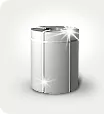In nature, there are a limited number of metals that have natural magnetic properties, and some of them are quite rare. However, the researchers managed to make magnets from two non-magnetic metals, copper and manganese, at room temperature. The discovery creates a new class of materials that can be useful for electronics and sensors.
Most materials exhibit some form of magnetism when placed in a magnetic field. In the case of a ferromagnet, or permanent magnet, these properties remain even after the magnetic field is turned off. Most of the products that use magnets - sensors, motors, electronics - contain iron, cobalt, nickel, or their alloys. But this is a limited list, so researchers are turning to synthetic magnets. Scientists made a magnet from copper and manganese using fancy soccer-ball-shaped carbon molecules. Fullerenes are made entirely of carbon atoms and pull electrons from a nearby metal.
To create a magnet, the researchers coated a non-magnetic chip with a thin layer of fullerenes followed by a thin layer of copper or manganese just 20 nanometers thick, and were able to demonstrate that the magnetic properties were retained after being removed from the magnetic field. That being said, the magnetization is not strong enough to attach to the refrigerator, but for the first time represents ferromagnetism in copper and manganese at room temperature.
Next, the scientists figured out exactly how the materials generate their magnetism, implying that magnetism arose at the boundary between the layers. To verify this, the researchers turned to unconventional methods known as muon spinning. They found that the magnetism of the metal /carbon structure is about 30 times weaker than that of iron. But lead author Oscar Cespedes thinks there is a lot of room for improvement. “We have to find the right combination of molecules and metal to maximize the effect,” he says.
Currently, the widespread industrial and technological applications of magnets require the use of rare earth elements such as neodymium. And it is getting more and more expensive. At the same time, permanent magnets made from readily available materials such as copper and coal can pave the way for greener technologies, reducing dependence on expensive minerals. In addition, fullerenes are biologically compatible and can be obtained in a chemical laboratory.
Scientists endow copper with magnetic properties

|
|
Azovpromstal® 9 August 2015 г. 11:57 |





